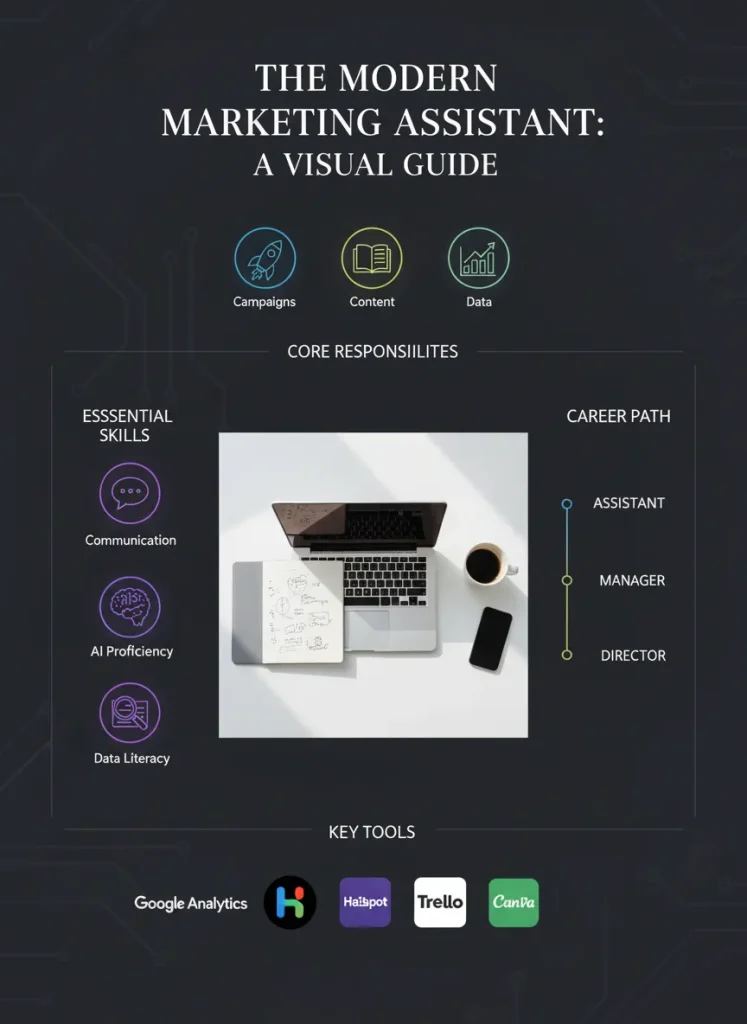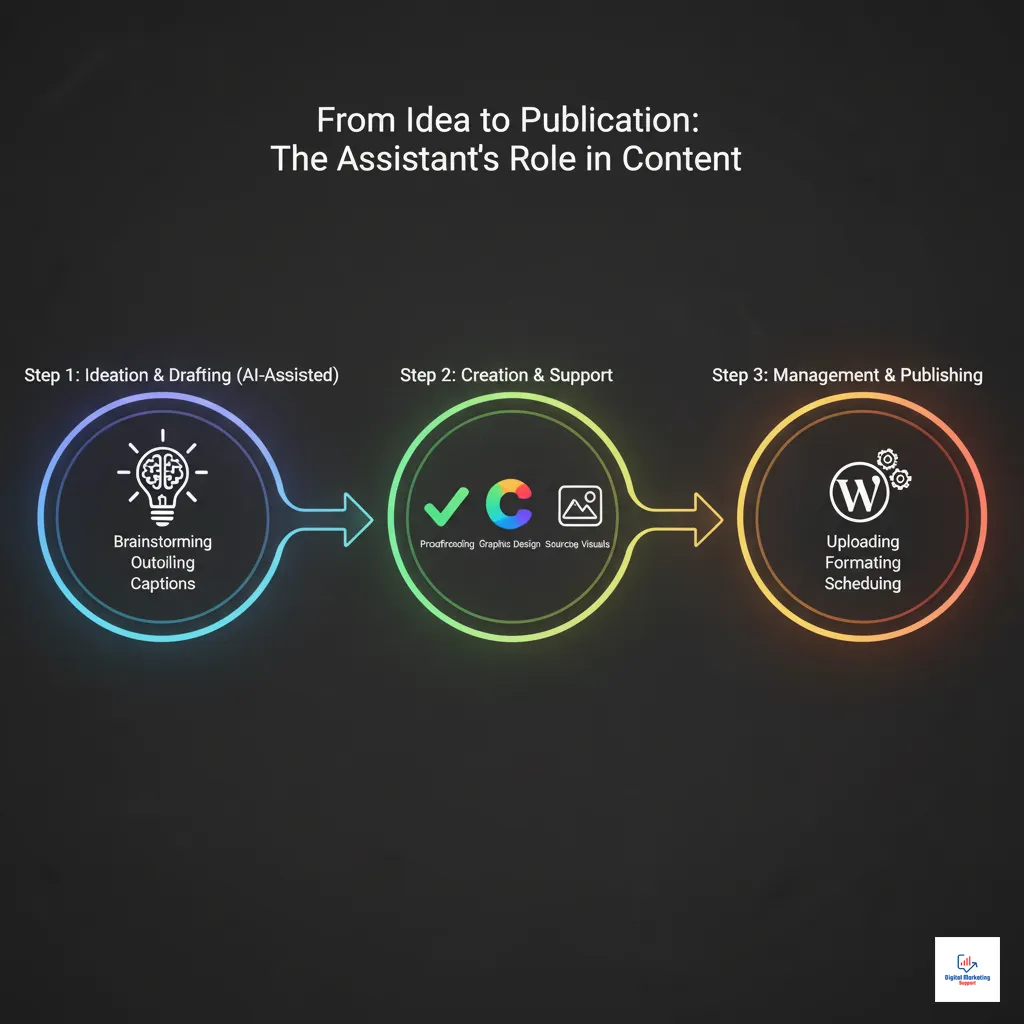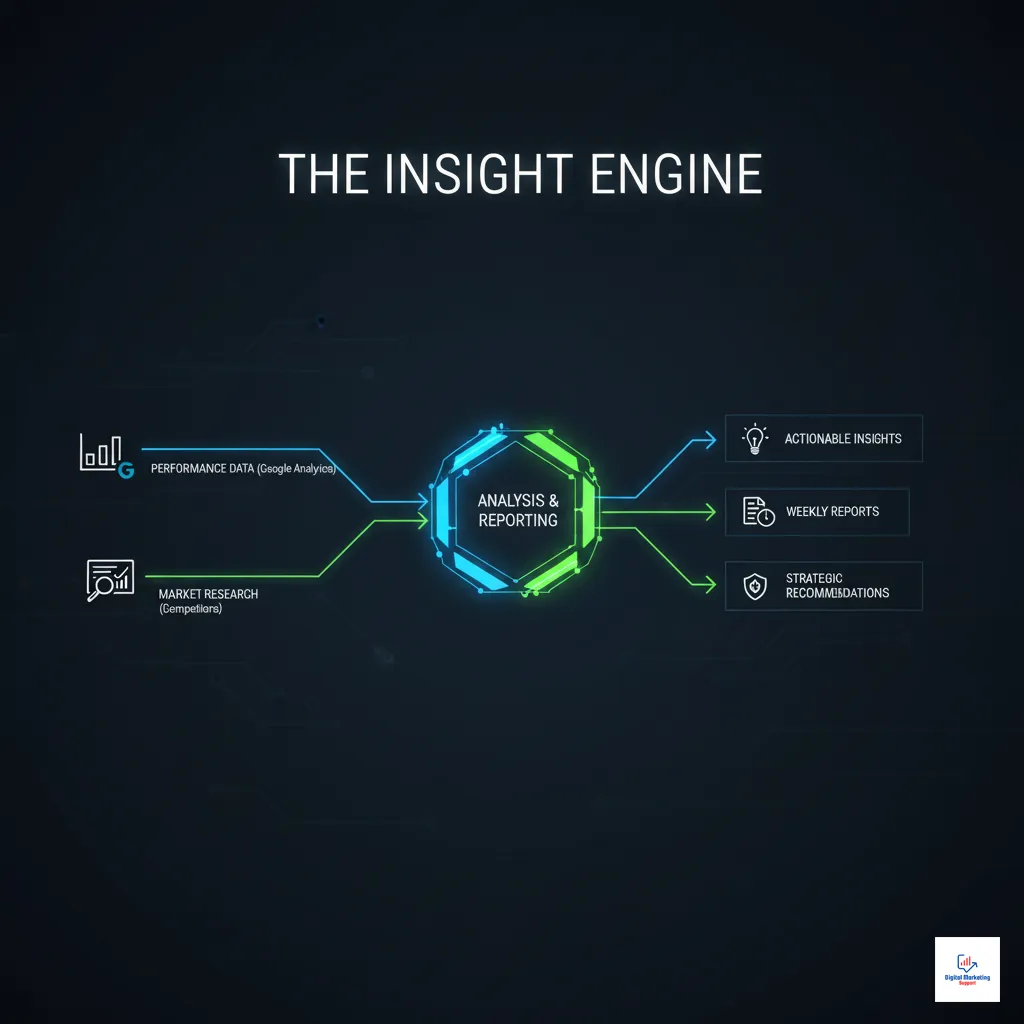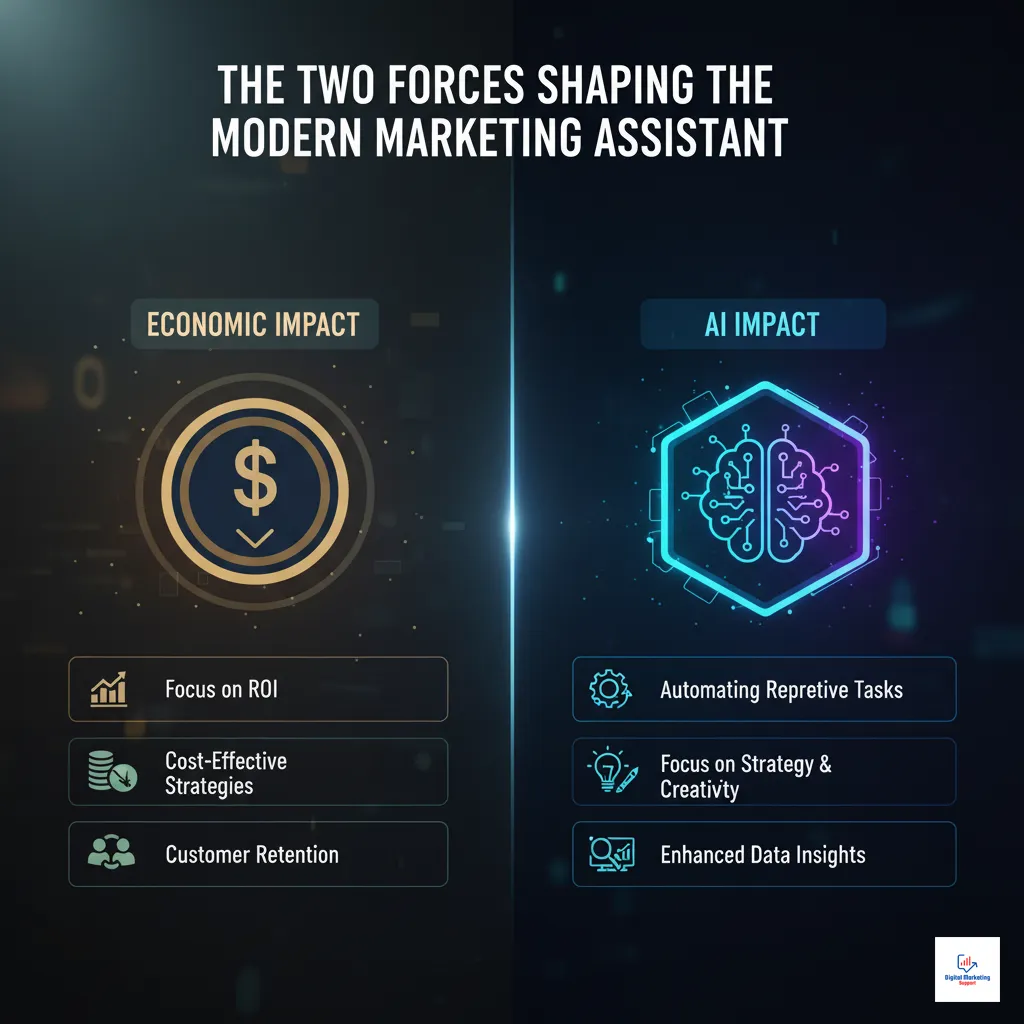Marketing departments today are navigating a fascinating intersection of pressures. On one side, economic uncertainty demands a sharper focus on return on investment for every dollar spent. On the other, the rapid rise of AI tools is fundamentally reshaping workflows. At the center of this dynamic environment is the marketing assistant, a role that has evolved far beyond simple administrative support. So, what does a marketing assistant do? They are the versatile backbone of the modern marketing team, responsible for executing the administrative, creative, and analytical tasks that bring larger strategies to life.
Table of Contents
This guide provides an in-depth, authoritative look into the marketing assistant’s responsibilities, skills, salary expectations, and career path. We’ll explore how technology and economic trends are transforming this foundational position from a support role into a strategic launchpad for a successful career. Understanding the full scope of what a marketing assistant does is the first step for anyone looking to enter this exciting field or for businesses aiming to leverage this role to its full potential.

The Evolving Core Responsibilities: Beyond Administrative Support
The classic image of a marketing assistant handling paperwork and scheduling meetings is outdated. Today’s marketing assistant jobs demand a dynamic skill set, with responsibilities that directly impact campaign success and business growth. The role is less about support and more about active participation in the marketing engine.

Digital Marketing & Campaign Execution
A significant portion of a marketing assistant’s duties are rooted in the digital landscape. They are on the front lines, helping to execute and monitor the campaigns that connect a brand with its audience. The digital marketing assistant is an indispensable part of any modern team.
The marketing assistant’s responsibilities in this area are hands-on. They learn by doing, gaining invaluable experience in the core functions of digital outreach.

Social Media Management
A social media marketing assistant is responsible for maintaining a brand’s daily presence online. This involves creating content calendars and scheduling posts across platforms like Instagram, TikTok, and LinkedIn using tools like Hootsuite or Buffer. They also actively monitor engagement, respond to comments to foster community, and help track social media analytics to understand what resonates with the audience.
Email Marketing Support
In email marketing, their support is crucial. They assist in creating and deploying newsletters and promotional campaigns using platforms like Mailchimp or HubSpot. Key marketing assistant responsibilities include managing and segmenting email lists, A/B testing subject lines to improve open rates, and analyzing campaign performance through open and click-through rates.
SEO & SEM Assistance
Even at an entry level, assistants are involved in search engine marketing. This includes foundational tasks like on-page search engine optimization (SEO), such as writing meta descriptions and title tags. They also conduct basic keyword research using tools like Surfer SEO and help monitor the performance of Google Ads campaigns, making this a great entry-level marketing job for aspiring search specialists. For instance, a marketing assistant might be tasked with tracking the performance of a local SEM campaign for a small business, providing critical data to the marketing manager.
Content Creation & Management
Content is the fuel for nearly all marketing activities, and the marketing assistant plays a key role in the production pipeline. While they may not be the lead strategist, their support is essential for maintaining a consistent and high-quality content output.
Their involvement ensures that the content machine runs smoothly, from initial idea to final publication. These marketing assistant duties are vital for brand storytelling.

Content Support
A marketing assistant’s responsibilities often include supporting the content team by proofreading blog posts and articles for grammar and style. They might source royalty-free images, create simple graphics for social media using Canva, and upload finished content to a content management system (CMS) like WordPress, ensuring everything is formatted correctly.
Leveraging AI for Content Ideation
The modern marketing assistant leverages technology to enhance creativity and efficiency. They use AI tools like ChatGPT or Notion AI to brainstorm blog topics, draft social media captions, and generate content outlines. This allows them to handle initial creative work, freeing up senior team members for more strategic planning. This is a key evolution in what a marketing assistant does today.
Data Analysis & Market Research
In a data-driven world, even entry-level marketing jobs require a comfort level with numbers. A marketing assistant helps gather and organize the information that informs marketing strategy, turning raw data into actionable insights.
These analytical responsibilities are what elevate the role from purely administrative to strategically important.

Performance Reporting
A core duty is pulling data from Google Analytics to report on website traffic, user behavior, and conversion goals. This often involves creating dashboards or weekly performance reports for the marketing manager. This experience is invaluable, as it teaches them how to connect marketing activities to business outcomes, a critical skill for any marketing career path.
Competitor and Industry Research
Understanding the competitive landscape is essential. The marketing assistant often monitors competitors’ marketing campaigns, social media presence, and pricing strategies. This research provides actionable insights for their own team, helping them identify opportunities and threats in the market. According to recent industry reports, consistent competitor analysis can improve marketing strategy effectiveness by up to 20%.
Essential Skills for the Modern Marketing Assistant
To thrive in this role, a unique combination of hard and soft skills is required. The marketing assistant is no longer just an administrator; they are a budding strategist and a tech-savvy implementer. The right marketing assistant skills can accelerate a career.

Foundational Hard & Soft Skills
These are the non-negotiable skills that form the bedrock of a competent marketing assistant.
- Hard Skills: Technical proficiency is a must. This includes familiarity with CRM software (Salesforce, HubSpot), project management tools (Trello, Asana), the full Microsoft Office Suite, and basic knowledge of the Adobe Creative Suite.
- Soft Skills: Equally important are strong communication skills for writing clear copy and collaborating with the team. Exceptional organization, proactive time management, creativity, and a keen attention to detail are also vital.
The New-Age Technical & Analytical Skills
The skills that set a candidate apart today are those that align with the future of marketing.
- Data Literacy: It’s no longer enough to just pull data. The ability to interpret what it means, identify trends, and ask insightful questions is a game-changer. This analytical mindset is a core component of in-demand marketing assistant skills.
- AI Proficiency: Comfort with generative AI tools is rapidly becoming a standard expectation. Knowing how to use them effectively for efficiency and creative support, including basic prompt engineering, gives a candidate a significant edge.
- SEO Fundamentals: A solid understanding of how search engines work is no longer optional for anyone in a digital marketing assistant role. Knowing the basics of on-page SEO and keyword research is crucial for contributing to the team’s success.
Marketing Assistant vs. Related Roles: A Comparative Analysis
In the world of entry-level marketing jobs, titles can sometimes be confusing. While roles like marketing assistant, marketing coordinator, and marketing specialist may seem similar, they have distinct differences in responsibility, seniority, and strategic input. Understanding these nuances is key for anyone starting their marketing career path. The marketing assistant is typically the starting point, focused on execution and support, while a coordinator handles more logistics, and a specialist owns a specific channel.
| Feature | Marketing Assistant | Marketing Coordinator | Marketing Specialist |
| Primary Focus | Task Execution & Support | Project Coordination & Logistics | In-Depth Channel Management |
| Key Responsibilities | Administrative tasks, data entry, social media scheduling, research. | Managing campaign timelines, liaising with vendors, content calendar oversight. | Managing SEO, running PPC campaigns, advanced social media strategy. |
| Strategic Involvement | Low; focused on implementing assigned tasks. | Moderate; helps organize and plan campaign logistics. | High; develops and executes strategy for a specific channel. |
| Average Salary (USA) | $45,000 – $60,000 | $55,000 – $70,000 | $65,000 – $85,000+ |
The Modern Marketing Assistant’s Toolkit
Proficiency with the right software is a major differentiator for candidates applying for marketing assistant jobs. The modern marketing assistant is expected to be fluent in a variety of platforms that help drive efficiency and effectiveness across the department. The table below highlights the essential tools they are expected to use in their daily tasks. Familiarity with this tech stack is a core requirement for what a marketing assistant does.
| Category | Tool Examples (Entities) | Primary Use Case |
| Project Management | Trello, Asana, Monday.com | Organizing tasks, tracking campaign progress, and managing deadlines. |
| Social Media Mgmt. | Hootsuite, Buffer, Sprout Social | Scheduling posts, monitoring engagement, and analyzing social metrics. |
| Email Marketing | Mailchimp, HubSpot, Constant Contact | Building email lists, deploying newsletters, and tracking campaign performance. |
| Analytics & SEO | Google Analytics, SEMrush, Surfer SEO | Monitoring website traffic, conducting keyword research, and tracking search rankings. |
| Content Creation | Canva, Adobe Express, Grammarly | Designing simple graphics, editing short videos, and proofreading copy. |
| AI & Productivity | ChatGPT, Jasper AI, Notion AI | Brainstorming ideas, drafting initial content, summarizing research, and organizing notes. |
| CRM | HubSpot, Salesforce | Managing customer data, tracking leads through the sales funnel, and supporting sales enablement. |
Salary, Job Outlook, and Career Progression (Data-Driven)
The marketing assistant role is more than just a job; it’s the primary entry point into a rewarding and dynamic industry with significant potential for growth. Understanding the financial prospects and career trajectory is essential for anyone considering this path.
Current Salary Expectations
The marketing assistant salary can vary based on several factors, but it offers a competitive starting wage. According to the latest data from the Bureau of Labor Statistics (BLS) and platforms like Glassdoor and Payscale, the average salary for a marketing assistant in the US ranges from $45,000 to $60,000.
This range is influenced by location, with major metropolitan areas like New York and San Francisco offering higher compensation to account for the cost of living. The industry also plays a role, with tech and finance companies often paying more than non-profits or retail. The latest average salary for a marketing assistant in the US reflects a role that is valued for its contribution to the bottom line.
A Promising Career Path
One of the most appealing aspects of starting as a marketing assistant is the clear and promising career path. The role provides comprehensive, hands-on experience across all marketing functions, creating a solid foundation for future advancement. The typical marketing career path progression is as follows:

- Marketing Assistant: The starting point, focused on support and execution.
- Marketing Coordinator or Digital Marketing Specialist: After 1-3 years, an assistant can move into a role with more responsibility, either coordinating projects or specializing in a channel like SEO, social media, or email marketing.
- Marketing Manager: With several years of experience, one can advance to a management role, overseeing strategy and leading a team.
- Marketing Director or VP of Marketing: This senior-level position involves overseeing the entire marketing department and setting the company’s overall marketing strategy.
The experience gained from a junior marketing associate role is invaluable. For instance, a marketing assistant who excels at using Google Analytics to generate reports might transition into a dedicated Marketing Analyst position, a highly in-demand specialty.
How to Become a Marketing Assistant (Actionable Guide)
Breaking into the field is achievable, even for those without direct professional experience. The key is to demonstrate passion, a willingness to learn, and a proactive approach to building relevant skills. Here’s how to become a marketing assistant with no experience.

Education, Certifications, and Building a Portfolio
A strong foundation can make all the difference when applying for entry-level marketing jobs.
- Education: While a bachelor’s degree in Marketing, Business, or Communications is common and helpful, it’s not always a strict requirement. What matters most is demonstrated knowledge and skill.
- Certifications: Stand out from the crowd by earning valuable certifications. Many are free and highly respected, including the Google Analytics IQ, HubSpot Inbound Marketing Certification, and the Google Ads Search Certification. Listing these on your resume shows initiative and a foundational understanding of key tools.
- Portfolio: This is the most critical element for those without experience. You can build a portfolio by volunteering for a local nonprofit, starting a personal blog to showcase your writing and SEO skills, or managing the social media accounts for a small local business. Document your work and results to create compelling case studies.
Summary & Key Takeaways
The role of the marketing assistant has fundamentally transformed into a dynamic and strategically important position. Far from being a simple administrative job, it is the engine room of the modern marketing department. To answer the question “what does a marketing assistant do?” is to describe a multifaceted professional who handles everything from digital campaign execution and content creation to data analysis and market research.

The key takeaways are clear. Success in this role today hinges on a blend of foundational skills and forward-thinking competencies. Adaptability, strong data literacy, and a growing proficiency with AI tools are no longer optional extras but core requirements. For those willing to embrace these challenges, the marketing assistant job is not just an entry-level position; it is a powerful launchpad for a long and successful career in the ever-evolving world of marketing.
Frequently Asked Questions (FAQs)
What is the main role of a marketing assistant?
A marketing assistant’s primary role is to provide administrative and operational support to the marketing team, helping to execute campaigns, manage social media, conduct research, and analyze data to ensure marketing strategies are implemented effectively.
Is being a marketing assistant a good entry-level job for a long-term career?
Absolutely. It is an excellent entry-level job because it provides hands-on exposure to nearly every facet of marketing, from digital and content to analytics and strategy. This broad experience builds a strong foundation for future advancement and specialization.
What are the top 3 skills needed to succeed as a modern marketing assistant?
The top three skills are strong communication (both written and verbal), digital literacy (including proficiency with social media and email platforms), and organizational skills to manage multiple tasks and deadlines effectively.
How is AI impacting the daily tasks of a marketing assistant?
AI is automating many of the repetitive daily tasks of a marketing assistant, such as drafting initial social media copy, summarizing research, and pulling basic data. This allows them to focus on more strategic and creative work like campaign analysis, content brainstorming, and interpreting AI-driven insights.
What is the typical career progression after working as a marketing assistant?
A typical career path involves advancing to roles like Marketing Coordinator or Digital Marketing Specialist. From there, one can progress to Marketing Manager, Brand Manager, or Marketing Analyst, and eventually to senior leadership positions like Marketing Director.
How much does a marketing assistant make in the USA?
The average salary for a marketing assistant in the United States typically falls between $45,000 and $60,000 annually. This can vary significantly based on location, industry, and the candidate’s experience level.
What is the difference between a marketing assistant and a marketing coordinator?
A marketing assistant is generally focused on task execution and administrative support. A marketing coordinator often has more project management responsibilities, such as managing campaign timelines, liaising between different teams or vendors, and overseeing logistical elements.
What tools and software should an aspiring marketing assistant learn?
An aspiring marketing assistant should learn Google Analytics, a CRM like HubSpot or Salesforce, email marketing software like Mailchimp, social media management tools like Hootsuite, and project management platforms like Trello or Asana.
How can I get a marketing assistant job with no professional experience?
Focus on building a strong portfolio through internships, volunteering for a nonprofit, or creating personal projects like a blog. Earn relevant industry certifications from Google or HubSpot and highlight transferable skills like communication, organization, and creativity on your resume.
What are the biggest challenges in a marketing assistant role?
The biggest challenges often include managing a high volume of diverse tasks with tight deadlines, the pressure to show measurable results for campaigns, and the need to constantly adapt to new technologies and marketing trends.








